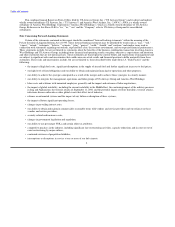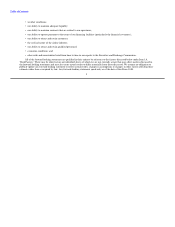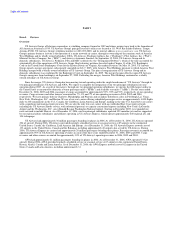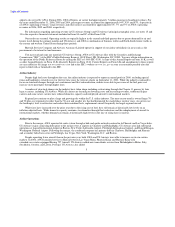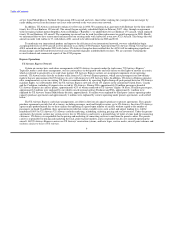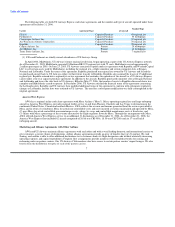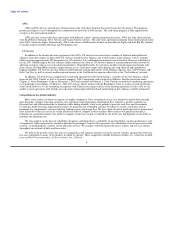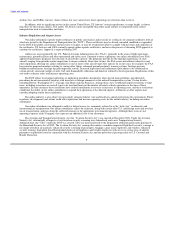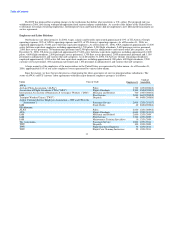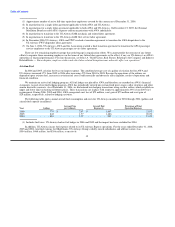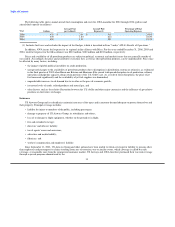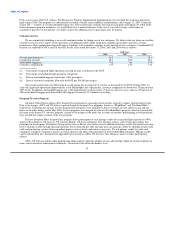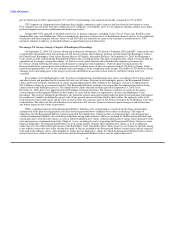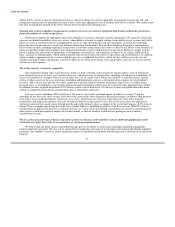US Airways 2006 Annual Report Download - page 15
Download and view the complete annual report
Please find page 15 of the 2006 US Airways annual report below. You can navigate through the pages in the report by either clicking on the pages listed below, or by using the keyword search tool below to find specific information within the annual report.
Table of Contents
(1) Approximate number of active full-time equivalent employees covered by the contract as of December 31, 2006.
(2) In negotiations for a single labor agreement applicable to both AWA and US Airways.
(3) In negotiations for a single labor agreement applicable to both AWA and US Airways. On December 15, 2005, the National
Mediation Board recessed AFA's separate contract negotiations with AWA indefinitely.
(4) In negotiations to transition to the US Airways-IAM mechanic and related labor agreement.
(5) In negotiations to transition to the US Airways-IAM fleet service labor agreement.
(6) In December 2006, US Airways, AWA and TWU reached a transition agreement to transition the AWA dispatchers to the
US Airways-TWU dispatcher labor agreement.
(7) On June 1, 2006, US Airways, AWA and the Association reached a final transition agreement to transition the AWA passenger
service employees to the US Airways passenger service labor agreement.
There are few remaining employee groups that could engage in organization efforts. We cannot predict the outcome of any future
efforts to organize those remaining employees or the terms of any future labor agreements or the effect, if any, on US Airways' or AWA's
operations or financial performance. For more discussion, see Item 1A. "Risk Factors, Risk Factors Relating to the Company and Industry
Related Risks — Union disputes, employee strikes and other labor-related disruptions may adversely affect our operations."
Aviation Fuel
In 2006 and 2005, aviation fuel was our largest expense. The combined average cost of a gallon of aviation fuel for AWA and
US Airways increased 17% from 2005 to 2006 after increasing 47% from 2004 to 2005. Because the operations of the airlines are
dependent upon aviation fuel, increases in aviation fuel costs could materially and adversely affect liquidity, results of operations and
financial condition.
We maintain an active fuel hedging program. All fuel hedges are placed by AWA and therefore are recorded on AWA's financial
statements. As part of our fuel hedging program, AWA has periodically entered into certain fixed price swaps, collar structures and other
similar derivative contracts. As of December 31, 2006, we had entered into hedging transactions using costless collars, which establish an
upper and lower limit on heating oil futures prices. These transactions are in place with respect to approximately 29% of our 2007 fuel
requirements. During 2006, 2005 and 2004, AWA recognized a net loss of $79 million, a net gain of $75 million and a net gain of
$24 million, respectively, related to hedging activities.
The following table shows annual aircraft fuel consumption and costs for US Airways mainline for 2004 through 2006 (gallons and
aircraft fuel expense in millions):
Average Price Aircraft Fuel Percentage of Total
Year Gallons per Gallon(1) Expense(1) Operating Expenses
2006 775 $ 2.07 $ 1,607 21.5%
2005 842 1.77 1,486 20.0%
2004 884 1.12 991 13.4%
(1) Includes fuel taxes. US Airways had no fuel hedges in 2006 and 2005 and the impact has been excluded for 2004.
In addition, US Airways incurs fuel expense related to its US Airways Express operations. For the years ended December 31, 2006,
2005 and 2004, total fuel expense for MidAtlantic, US Airways Group's wholly owned subsidiaries and affiliate carriers was
$554 million, $468 million, and $206 million, respectively.
12


